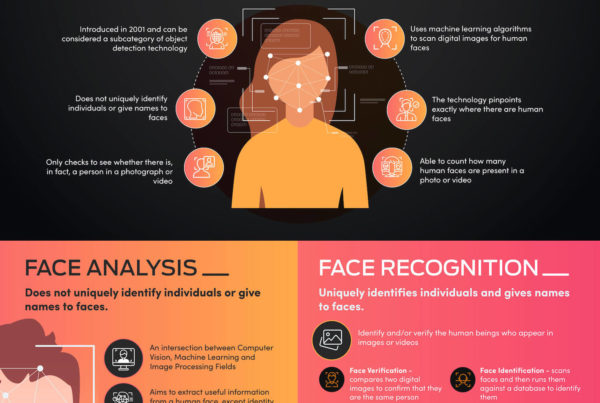 Despite tremendous technological progress, understanding human emotion with face analysis is a complex task. At present, many artificial intelligence (AI) algorithms are already capable of detecting different facial micro-expressions with precision, but they are not always capable of understanding the true meaning of our emotions.
Despite tremendous technological progress, understanding human emotion with face analysis is a complex task. At present, many artificial intelligence (AI) algorithms are already capable of detecting different facial micro-expressions with precision, but they are not always capable of understanding the true meaning of our emotions.
Why Analysis of Human Emotions Is Complex for Machines
Human emotions are not black and white. In fact, we operate on an emotional spectrum. Research found that we have 19 different types of smiles, but only six happen when we’re having a good time. That’s because we also smile when we are nervous, embarrassed, or even in pain. These intricacies may be harder for AI algorithms to interpret without additional context.
 Also, cultural backgrounds play a role in the way we express different emotions. People from certain nations are more emotional, while others are more reserved—deadpan even. Researchers from Google and Berkeley found that people from different cultures “share about 70% of the facial expressions used in response to different social and emotional situations.” That is a lot but not always enough for accurate machine-based interpretation.
Also, cultural backgrounds play a role in the way we express different emotions. People from certain nations are more emotional, while others are more reserved—deadpan even. Researchers from Google and Berkeley found that people from different cultures “share about 70% of the facial expressions used in response to different social and emotional situations.” That is a lot but not always enough for accurate machine-based interpretation.
As the above findings show, individual reactions and emotional responses can be highly circumstantial. You can confuse a customer feedback tool, for example by using sarcasm and saying how great the service was, when in reality your fuming cheeks and furrowed brow suggest otherwise to a fellow human. This factor makes text-based sentiment analysis less effective compared to text responses that also use face analysis. Then AI can use emotions as part of the interpretation.
Understanding Human Emotion With Face Analysis: Use Cases
Training a machine to decode human emotions is a challenging task, requiring significant investment in data collection, sampling, and labeling, plus subsequent face analysis model training. AlgoFace AI proposes a shorter time-to-market for new products.
Our FaceTrace face analysis technology is pre-trained to recognize any skin tone and effectively captures facial subtle movement through advanced face landmarks tracking. This enables you to incorporate a new level of depth and interactivity into your products or launch completely new product offerings. Below are several use cases illustrating what is achievable today with face analysis technology.
Monitoring Driver Behavior
Driving can be a fun activity when embarking on a much-awaited road trip. But sitting behind the wheel can easily become stressful and tiring, especially when the driving conditions are bad, the traffic is heavy, and the kids won’t stop fussing around in the backseat.
 According to the National Highway Traffic Safety Administration (NHTSA), over 3,100 people were killed in accidents caused by distracted driving in 2019. Drowsiness, stress, and overall driver mood also have a scientifically proven impact on driving style. Angry or distressed drivers are more likely to engage in risky behaviors and violate rules—and that rarely ends well.
According to the National Highway Traffic Safety Administration (NHTSA), over 3,100 people were killed in accidents caused by distracted driving in 2019. Drowsiness, stress, and overall driver mood also have a scientifically proven impact on driving style. Angry or distressed drivers are more likely to engage in risky behaviors and violate rules—and that rarely ends well.
Emotion-aware driver behavior monitoring systems can lead to safer roads. By continuously examining the driver’s facial expressions, face analysis can detect early signs of fatigue, sleepiness, or stress and then alert the driver and help them moderate their behavior. For example, face analysis-powered infotainment systems can prompt drivers to take a break, slow down, or switch to assisted driving for greater safety.
How AlgoFace Helps
FaceTrace is deployed on the edge, meaning at the connected car hardware level, which allows your solutions to perform faster face analysis even with an unstable internet connection. Moreover, on-device data processing also means less data movement, lending to greater customer privacy.
Improving eLearning and Online Training
 Over the past year, many of us have (re)discovered the joys and frustration of online learning. For many adults, remote learning is more productive and effective than attending in-person classes. Others, however, find online training less personable and miss the camaraderie of in-person sessions.
Over the past year, many of us have (re)discovered the joys and frustration of online learning. For many adults, remote learning is more productive and effective than attending in-person classes. Others, however, find online training less personable and miss the camaraderie of in-person sessions.
Educators also express mixed feelings. Some are eagerly using novel technologies such as augmented reality (AR), virtual reality (VR), and AI to develop engaging, personalized, and highly realistic training scenarios for students. Others complain about the questionable effectiveness of online-only classes in kindergarten through high school.
Infusing emotion analysis capabilities into eLearning products can help improve student engagement and satisfaction. For instance, by scanning the learner’s face during modules, you can capture their emotional responses—such as happy, sad, or confused—to different types of assignments and adjust accordingly. Face analysis can also detect early signs of fatigue and the level of engagement, so you can suggest taking a break.
How AlgoFace Helps
AlgoFace developed light-weight, fast face tracking technology conducive to scalable deployments for a large number of users. Our technology can still work in poor lighting conditions, so those folks prone to late-night cramming sessions can still benefit. t.
Measuring Patient Pain Levels
Typically, a scowl and an “ouch” are how you show the world you’re in pain after you stub your toe. But patients with chronic illnesses, speech impairments, and age-related conditions such as dementia often have a harder time communicating their pain levels to a healthcare provider.
 Face analysis algorithms can help medical professionals adequately measure the patient’s pain levels by monitoring their faces for distress signals. In fact, even 2D face analysis, paired with AI-powered movement motion analysis, has been field-tested to deliver 92% to 99% accuracy in pain level predictions.
Face analysis algorithms can help medical professionals adequately measure the patient’s pain levels by monitoring their faces for distress signals. In fact, even 2D face analysis, paired with AI-powered movement motion analysis, has been field-tested to deliver 92% to 99% accuracy in pain level predictions.
In this way, healthcare providers can prescribe the right medication, dosage, and even keep track of administration remotely. By augmenting medical data such as a patient’s sleep schedule, mood, and medication usage patterns with face analysis insights, health practitioners can obtain a more comprehensive assessment of the patient’s condition. They can then apply evidence-based pain management practices to improve the quality of care.
How AlgoFace Helps
Our FaceTrace algorithm uses 209 face landmarks to assist in the interpretation of a person’s emotions, leaving little room for ambiguity. We are also training our models on representative datasets, featuring people from different backgrounds and cultures to achieve consistently high accuracy levels.
Understanding Human Emotion With Face Analysis: What’s Next?
A technology with high accuracy and robust data processing capabilities is crucial for emotion analysis. To be effective, the solution will require a diverse range of data inputs and data points, as well as the ability to accurately analyze diverse facial structures and emotional responses.
For AlgoFace, commitment to inclusive AI is an operational priority. All our face analysis solutions are trained on diverse, inclusive samples, which are representative of modern populations.
Initially, not all customers may feel compelled to share intimate information such as their emotional states with a “faceless” corporation. Many will ask about the security safeguards and privacy protection you have in place. By operating on the edge and never capturing end user biometrics or other data we put privacy first. Plus, we operate ethically, pledging to never use our face AI technology for facial recognition or profiling.
Request a free trial of AlgoFace’s AI technology to get a better sense of our platform’s emotion detection capabilities.




